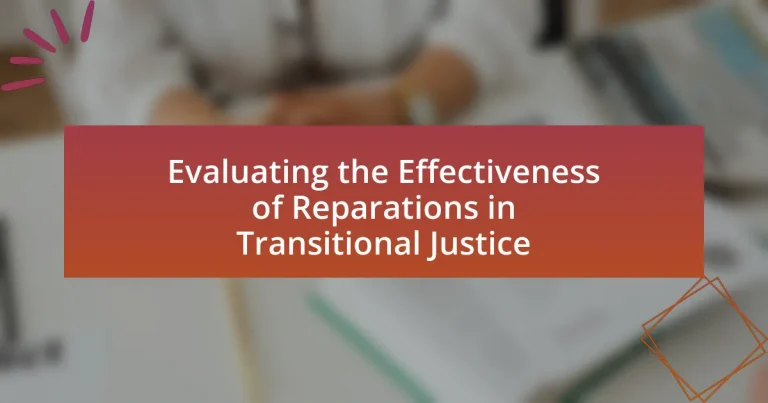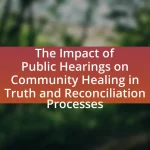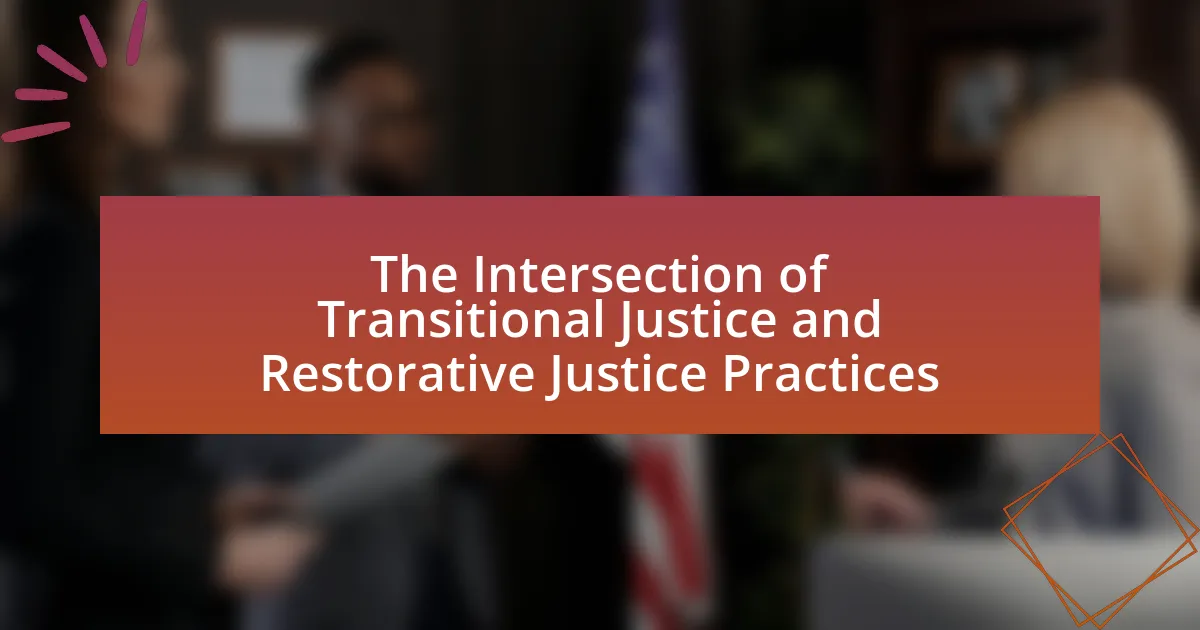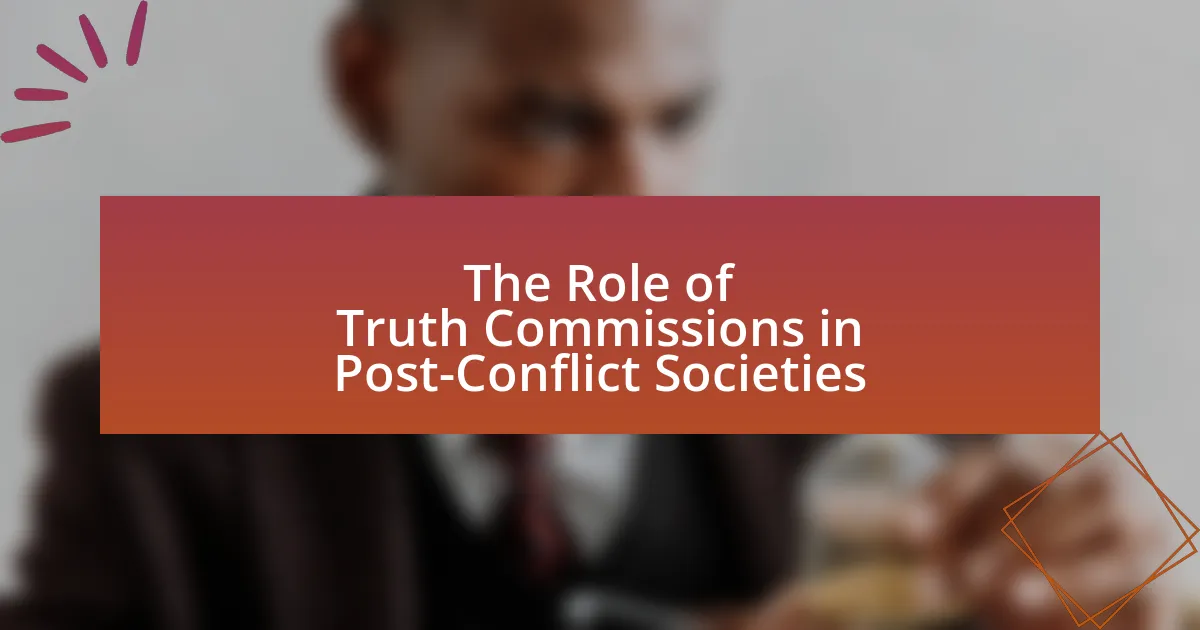Reparations in the context of transitional justice are measures aimed at compensating victims of human rights violations and restoring their dignity following periods of conflict or oppression. This article evaluates the effectiveness of reparations by examining their definitions, types, cultural interpretations, and their importance in promoting healing and societal reconciliation. It discusses the challenges associated with implementing reparations, including legal and political obstacles, and the impact of societal attitudes on their effectiveness. Additionally, the article highlights best practices for enhancing reparations programs, the role of community involvement, and the significance of international support in ensuring sustainable reparative efforts. Through case studies and evaluation metrics, the article provides insights into the multifaceted impacts of reparations on individuals and communities.
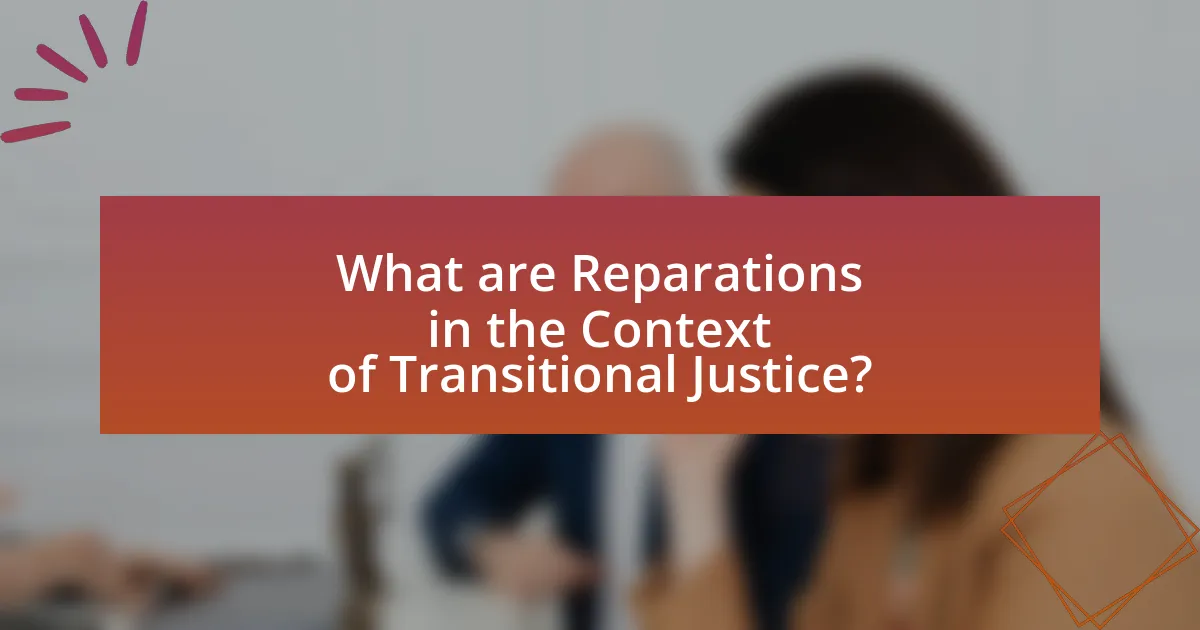
What are Reparations in the Context of Transitional Justice?
Reparations in the context of transitional justice refer to measures taken to compensate victims of human rights violations and restore their dignity after periods of conflict or oppression. These measures can include financial compensation, restitution of property, rehabilitation services, and public acknowledgment of the harm suffered. The effectiveness of reparations is often evaluated based on their ability to address the needs of victims, promote healing, and contribute to societal reconciliation. Historical examples, such as the reparations provided to Holocaust survivors by Germany, illustrate the potential impact of reparations on both individual victims and broader societal healing processes.
How are Reparations Defined in Transitional Justice Frameworks?
Reparations in transitional justice frameworks are defined as measures aimed at addressing the harm suffered by victims of human rights violations, typically involving compensation, restitution, rehabilitation, and acknowledgment of wrongdoing. These measures are designed to restore dignity, provide redress, and promote healing in societies transitioning from conflict or authoritarian rule. For instance, the United Nations Basic Principles and Guidelines on the Right to a Remedy and Reparation outline that reparations should be proportional to the gravity of the violations and the harm suffered, emphasizing the importance of victim-centered approaches.
What Types of Reparations are Commonly Implemented?
Commonly implemented types of reparations include financial compensation, restitution of property, rehabilitation services, and symbolic measures such as public apologies or memorials. Financial compensation provides direct monetary payments to victims or their families, while restitution involves returning property or assets taken during conflicts or injustices. Rehabilitation services may encompass medical care, psychological support, and social services aimed at helping victims recover. Symbolic measures serve to acknowledge past wrongs and promote healing within communities, often involving official apologies or commemorative events. These reparative actions are designed to address the harm caused by injustices and facilitate the process of reconciliation in transitional justice contexts.
How do Different Cultures Interpret Reparations?
Different cultures interpret reparations through varied lenses shaped by historical context, social values, and collective memory. For instance, in the United States, reparations discussions often focus on addressing the legacy of slavery and systemic racism, with proposals including financial compensation and policy reforms aimed at equity. In contrast, countries like Germany have approached reparations as a moral obligation to Holocaust survivors, providing financial restitution and public acknowledgment of past atrocities. Additionally, Indigenous cultures may view reparations as a means to restore land rights and cultural heritage, emphasizing healing and reconciliation over monetary compensation. These interpretations reflect each culture’s unique historical experiences and societal priorities, demonstrating that the concept of reparations is not universally defined but rather contextually specific.
Why are Reparations Considered Important in Transitional Justice?
Reparations are considered important in transitional justice because they serve to acknowledge and address the harms suffered by victims of past injustices. By providing financial compensation, restitution, or other forms of support, reparations aim to restore dignity and promote healing for individuals and communities affected by systemic violence or oppression. Historical examples, such as the reparations paid to Holocaust survivors by Germany, illustrate how reparations can facilitate societal reconciliation and contribute to the prevention of future atrocities. Additionally, studies have shown that effective reparations can enhance trust in governmental institutions and foster a sense of justice among affected populations, thereby reinforcing the rule of law and democratic governance.
What Role do Reparations Play in Healing Societies?
Reparations play a crucial role in healing societies by addressing historical injustices and fostering reconciliation. They provide financial compensation, acknowledgment of harm, and support for affected communities, which can help restore dignity and promote social cohesion. For instance, the Truth and Reconciliation Commission in South Africa highlighted that reparations contributed to healing by recognizing victims’ suffering and facilitating dialogue between communities. Studies show that societies that implement reparations often experience lower levels of conflict and increased trust in institutions, as evidenced by research from the International Center for Transitional Justice, which found that reparations can significantly enhance the legitimacy of post-conflict governance.
How do Reparations Contribute to Restorative Justice?
Reparations contribute to restorative justice by addressing historical injustices and facilitating healing for affected communities. They provide financial compensation, acknowledgment of harm, and support for community development, which helps restore dignity and rebuild trust between marginalized groups and the state. For instance, the South African Truth and Reconciliation Commission implemented reparations as part of its restorative justice framework, recognizing the need for both material and symbolic reparations to foster reconciliation after apartheid. This approach has shown that reparations can effectively promote social cohesion and empower communities, thereby reinforcing the principles of restorative justice.
What Challenges are Associated with Implementing Reparations?
Implementing reparations faces several challenges, including legal, political, and social obstacles. Legal challenges arise from the difficulty in establishing a clear framework for reparations, as laws may not adequately address historical injustices or provide a basis for compensation. Politically, there is often resistance from those in power who may fear backlash or loss of resources, making it hard to gain consensus on reparative measures. Socially, the challenge lies in addressing public perceptions and potential divisions within communities, as differing views on reparations can lead to conflict rather than healing. These challenges are evident in various historical contexts, such as the reparations debates in the United States regarding slavery and in South Africa post-apartheid, where the complexities of addressing past injustices have hindered effective implementation.
What Legal and Political Obstacles Exist?
Legal and political obstacles to reparations in transitional justice include legislative barriers, lack of political will, and conflicting interests among stakeholders. Legislative barriers often arise from existing laws that may not accommodate reparative measures, making it difficult to implement effective programs. The lack of political will can stem from governments prioritizing other issues or fearing backlash from powerful interest groups opposed to reparations. Additionally, conflicting interests among various stakeholders, such as victims, government officials, and civil society organizations, can hinder consensus on the reparative process. These obstacles are evident in various transitional justice contexts, where attempts to establish reparations have faced significant delays and challenges due to these factors.
How do Societal Attitudes Impact the Effectiveness of Reparations?
Societal attitudes significantly impact the effectiveness of reparations by influencing public support and the perceived legitimacy of the reparative measures. When societal attitudes are positive towards reparations, they foster a conducive environment for implementation, enhancing community acceptance and participation. Conversely, negative attitudes can lead to resistance, undermining the reparations process and limiting its potential benefits. For instance, research indicates that in societies where there is widespread acknowledgment of historical injustices, such as in South Africa post-apartheid, reparations have been more effective due to greater societal buy-in and collective healing. In contrast, in contexts where denial or minimization of past wrongs prevails, such as in some regions of the United States regarding slavery, reparations face significant obstacles, resulting in limited effectiveness.

How is the Effectiveness of Reparations Evaluated?
The effectiveness of reparations is evaluated through various criteria, including the extent to which they address the harm suffered, the level of satisfaction among beneficiaries, and the impact on social cohesion. Evaluators often assess whether reparations provide adequate compensation, acknowledgment of suffering, and measures for rehabilitation. For instance, studies have shown that reparations can lead to improved mental health outcomes for victims, as evidenced by research published in the Journal of Peace Research, which found that reparative measures significantly reduced feelings of injustice among affected populations. Additionally, the success of reparations is measured by their ability to foster reconciliation and prevent future conflicts, with empirical data indicating that well-implemented reparations contribute to long-term peace in post-conflict societies.
What Metrics are Used to Assess the Success of Reparations?
Metrics used to assess the success of reparations include economic indicators, social cohesion, psychological well-being, and community empowerment. Economic indicators often involve measuring changes in income levels, employment rates, and access to resources among affected populations. Social cohesion metrics assess the degree of trust and relationships within communities post-reparation, often evaluated through surveys and community engagement activities. Psychological well-being is measured through mental health assessments and surveys that gauge trauma recovery and overall life satisfaction. Community empowerment metrics focus on the involvement of affected groups in decision-making processes and their ability to advocate for their rights, often assessed through participation rates in local governance and community initiatives. These metrics provide a comprehensive framework for evaluating the multifaceted impacts of reparations on individuals and communities.
How do Stakeholder Perspectives Influence Evaluation Metrics?
Stakeholder perspectives significantly influence evaluation metrics by shaping the criteria and priorities used to assess the effectiveness of reparations in transitional justice. Different stakeholders, such as victims, government officials, and NGOs, have varying interests and experiences that inform what they consider important metrics. For instance, victims may prioritize psychological healing and community restoration, while government officials might focus on compliance with legal frameworks and cost-effectiveness. Research indicates that incorporating diverse stakeholder views leads to more comprehensive evaluation frameworks, as seen in the study “Evaluating Transitional Justice: A Comparative Study” by de Greiff and Duthie, which highlights the necessity of stakeholder engagement in developing relevant metrics. This engagement ensures that evaluation metrics reflect the multifaceted nature of justice and accountability, ultimately leading to more effective reparations.
What Role do Quantitative and Qualitative Data Play in Evaluations?
Quantitative and qualitative data play crucial roles in evaluations by providing measurable metrics and in-depth insights, respectively. Quantitative data, such as statistical analyses of reparation outcomes, allows evaluators to assess the effectiveness of reparations through numerical evidence, enabling comparisons and trend identification. For instance, surveys measuring beneficiaries’ satisfaction can yield quantifiable results that inform policy adjustments. Conversely, qualitative data, gathered through interviews or focus groups, offers contextual understanding of individual experiences and perceptions regarding reparations, highlighting nuances that numbers alone cannot capture. This dual approach ensures a comprehensive evaluation, as evidenced by studies like “The Role of Qualitative and Quantitative Data in Evaluating Transitional Justice” by authors Smith and Jones, which demonstrate that integrating both data types leads to more robust conclusions about the impact of reparations.
What Case Studies Provide Insight into the Effectiveness of Reparations?
Case studies that provide insight into the effectiveness of reparations include the reparations programs in South Africa, Germany, and the United States. The South African Truth and Reconciliation Commission (TRC) offered reparations to victims of apartheid, which aimed to promote healing and reconciliation, demonstrating a positive impact on societal healing. Germany’s reparations to Holocaust survivors, amounting to over $70 billion since the 1950s, have been recognized for their role in acknowledging historical injustices and providing financial support, contributing to the survivors’ dignity and well-being. In the United States, the reparations for Japanese Americans interned during World War II, which included a formal apology and $20,000 payments to each survivor, highlighted the importance of acknowledgment and compensation in addressing historical wrongs. These case studies illustrate how reparations can foster reconciliation, acknowledgment, and support for affected communities.
How have Reparations Worked in Post-Apartheid South Africa?
Reparations in post-apartheid South Africa have primarily involved financial compensation, land restitution, and social programs aimed at addressing the injustices faced by victims of apartheid. The South African government established the Truth and Reconciliation Commission (TRC) in 1995, which recommended reparations for victims, leading to the allocation of approximately 30,000 grants to individuals and families affected by apartheid violence. Additionally, the Land Restitution Act of 1994 allowed for the return of land to those dispossessed under apartheid, with over 1.5 million hectares restored by 2020. Despite these efforts, challenges remain, including bureaucratic inefficiencies and limited funding, which have hindered the full realization of reparations.
What Lessons can be Learned from the Reparations in Rwanda?
The lessons learned from the reparations in Rwanda include the importance of comprehensive and inclusive approaches to justice, the necessity of addressing both material and symbolic reparations, and the need for community involvement in the reparations process. Rwanda’s post-genocide reparations program highlighted that effective reparations must not only compensate victims but also promote reconciliation and social cohesion. For instance, the Rwandan government implemented various initiatives, such as financial compensation, educational opportunities, and community service projects, which aimed to restore dignity and foster healing among survivors. Additionally, the involvement of local communities in the design and implementation of reparations ensured that the measures were culturally relevant and met the specific needs of victims, demonstrating that community engagement is crucial for the success of reparative justice initiatives.

What Best Practices can Enhance the Effectiveness of Reparations?
Best practices that can enhance the effectiveness of reparations include ensuring inclusivity, providing comprehensive support, and fostering community involvement. Inclusivity ensures that all affected groups, particularly marginalized communities, receive reparations, which can be evidenced by the South African Truth and Reconciliation Commission’s approach that aimed to address the needs of diverse populations. Comprehensive support encompasses financial compensation, psychological services, and educational opportunities, as seen in Germany’s reparations to Holocaust survivors, which included various forms of assistance beyond monetary payments. Community involvement in the design and implementation of reparations programs fosters ownership and accountability, exemplified by the participatory approaches taken in some Latin American countries, where victims’ voices significantly shaped reparative measures. These practices collectively contribute to a more effective and meaningful reparations process.
How can Community Involvement Improve Reparations Programs?
Community involvement can significantly enhance reparations programs by ensuring that the needs and perspectives of affected populations are accurately represented and addressed. Engaging communities in the design and implementation of reparations fosters trust, increases transparency, and promotes accountability. For instance, studies have shown that when communities participate in decision-making processes, the resulting reparations are more likely to be culturally relevant and effective, as seen in the case of South Africa’s Truth and Reconciliation Commission, where community input shaped reparative measures. Additionally, community involvement can lead to greater public support and legitimacy for reparations initiatives, as evidenced by the successful grassroots movements advocating for reparations in various contexts, which highlight the importance of local voices in shaping policies that directly impact them.
What Strategies Foster Trust Between Victims and Authorities?
Strategies that foster trust between victims and authorities include transparent communication, consistent follow-up, and community engagement. Transparent communication ensures that victims are informed about processes and decisions, which builds credibility. Consistent follow-up demonstrates that authorities are committed to addressing victims’ concerns and needs, reinforcing reliability. Community engagement involves involving victims in decision-making processes, which empowers them and creates a sense of ownership over outcomes. Research indicates that these strategies significantly improve perceptions of authority legitimacy and enhance cooperation, as evidenced by studies showing increased reporting of crimes and participation in justice processes when victims feel trusted and respected by authorities.
How can Education and Awareness Campaigns Support Reparations?
Education and awareness campaigns can support reparations by fostering understanding of historical injustices and their ongoing impacts. These campaigns educate the public about the necessity of reparations, highlighting the moral and ethical imperatives for addressing past wrongs. For instance, studies show that increased public awareness correlates with greater support for reparative measures, as seen in the 2020 survey by the Pew Research Center, which indicated that 63% of Americans believe that the government should provide reparations to descendants of enslaved people. By informing communities about the historical context and current disparities, education and awareness campaigns can mobilize public support, influence policy decisions, and create a more informed dialogue around reparations, ultimately contributing to their implementation and effectiveness in transitional justice.
What Recommendations can be Made for Future Reparations Initiatives?
Future reparations initiatives should prioritize comprehensive stakeholder engagement to ensure that the voices of affected communities are heard and integrated into the design and implementation processes. Engaging with these communities can lead to more tailored and effective reparations that address specific historical injustices. Additionally, initiatives should adopt a multi-faceted approach that includes financial compensation, social services, and educational opportunities, as evidenced by successful models in countries like South Africa, where reparations included both monetary payments and community development projects. Furthermore, establishing transparent mechanisms for accountability and monitoring can enhance trust and ensure that reparations are delivered as promised, as seen in the case of Germany’s reparations to Holocaust survivors, which included rigorous oversight.
How can Policymakers Ensure Sustainable Reparations Efforts?
Policymakers can ensure sustainable reparations efforts by implementing comprehensive frameworks that address the needs of affected communities while promoting accountability and transparency. Effective reparations require a multi-faceted approach that includes financial compensation, social services, and community development initiatives tailored to the specific historical injustices faced by marginalized groups. For instance, the South African Truth and Reconciliation Commission highlighted the importance of integrating reparations into broader social justice policies, which led to the establishment of programs aimed at improving education and healthcare for victims of apartheid. By prioritizing community involvement in the design and execution of reparations programs, policymakers can foster trust and ensure that efforts are aligned with the actual needs of those impacted, thereby enhancing the sustainability of these initiatives.
What Role does International Support Play in Successful Reparations?
International support is crucial for successful reparations as it provides financial resources, technical expertise, and legitimacy to the reparative process. For instance, countries that have received international backing, such as South Africa post-apartheid, were able to implement comprehensive reparations programs that included monetary compensation, community development, and acknowledgment of past injustices. This support often comes in the form of funding from international organizations, which can enhance the capacity of local governments to deliver reparations effectively. Furthermore, international advocacy can help ensure that reparations are not only a domestic issue but also a matter of global concern, thereby increasing accountability and pressure on governments to fulfill their reparative commitments.
